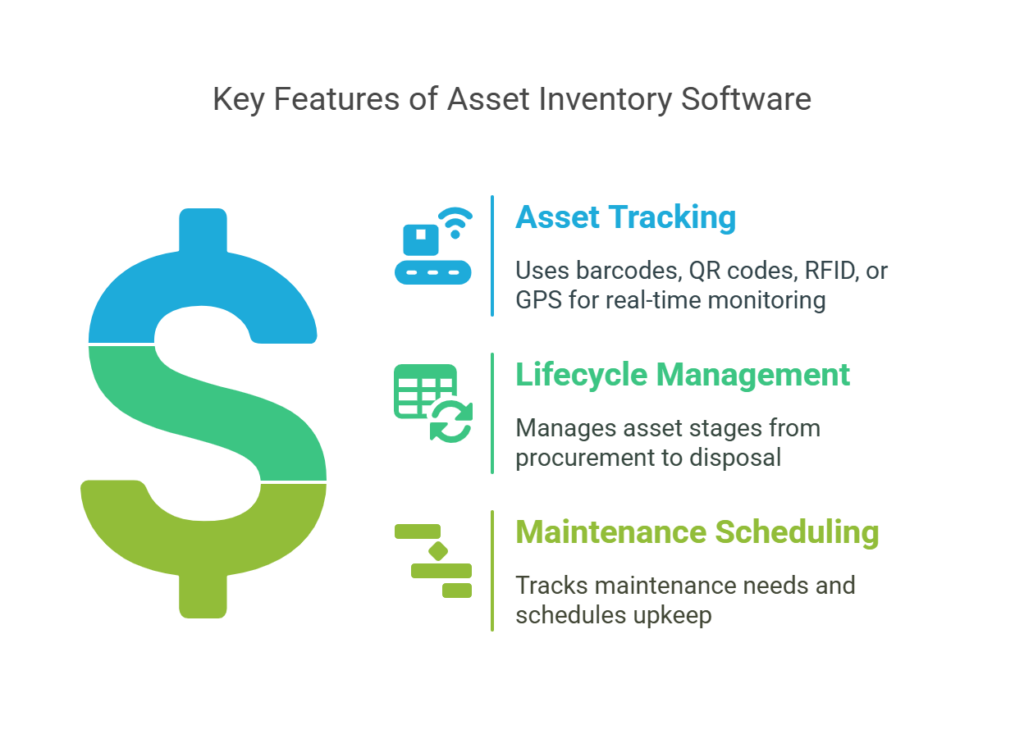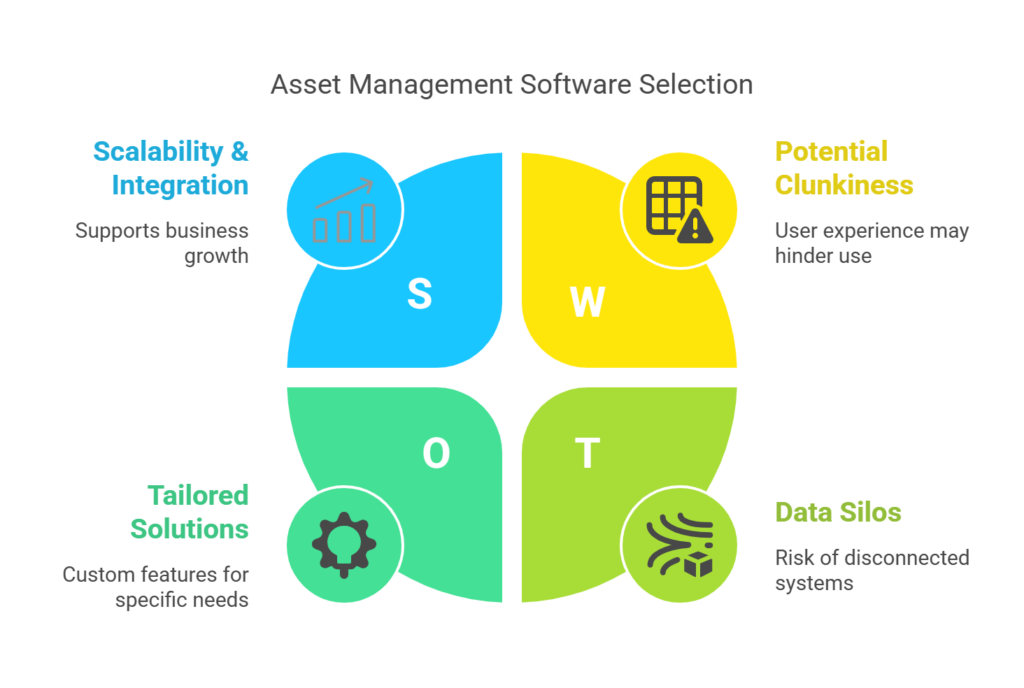Ever feel like your company’s assets have a mind of their own, vanishing when you need them most? 👻 It’s a common headache! Poor asset management isn’t just annoying; it can seriously drain resources. Studies suggest businesses can lose significant amounts each year due to misplaced, underutilized, or “ghost” assets (items still on the books but physically missing).
That’s where asset inventory software steps in as a game-changer. It’s about gaining control, visibility, and efficiency over everything your company owns – from laptops and machinery to software licenses and vehicles. Getting a grip on your assets means smarter spending, smoother operations, and less time wasted searching. Let’s explore how this technology makes a real difference.
What is Asset Inventory Software?
Think of asset inventory software as a central command center for all your company’s valuable items. It’s a specialized tool designed to help you track, monitor, and manage the entire lifecycle of your business assets. Instead of relying on messy spreadsheets or outdated paper records (yikes! 😱), this software provides a digital, organized, and easily accessible database.
Its main job is to give you a clear picture of what assets you have, where they are, who is using them, their current condition, maintenance history, and financial value. This covers everything valuable the company owns. As Indeed puts it:
“Asset inventory management is a method companies employ to track and update the status of every asset the company has, whether they’re tangible, intangible, fixed or liquid.” -Indeed
Key Features of Asset Inventory Software
So, what magical ingredients make this software so effective? Good asset inventory systems come packed with features designed to make life easier. Core among these is robust asset tracking. This often involves using barcodes, QR codes, RFID tags, or even GPS to monitor the location and status of each item in real-time or near real-time. No more hide-and-seek with essential equipment!
Another vital feature is asset lifecycle management. This covers everything from procurement and deployment to maintenance, upgrades, and eventual disposal. Understanding where an asset is in its lifecycle helps plan replacements, calculate depreciation accurately, and maximize its value. Tied closely to this is maintenance scheduling. The software can track maintenance needs, schedule preventative upkeep, and record repair histories, reducing unexpected breakdowns and extending asset lifespan. ⚙️

These features work together to provide a comprehensive overview. They help minimize loss, optimize usage, ensure equipment is available and functional when needed, and provide data for smarter decisions about future purchases or repairs. Limble CMMS highlights several must-haves:
“Asset management platforms: 6 must-have features · 1. Asset tracking · 2. Asset lifecycle management · 3. Maintenance planning and scheduling · 4.” -Limble CMMS
Benefits of Implementing Asset Inventory Software
Putting asset inventory software in place brings a wave of positive changes. First off, you get massively improved organization. Having a single source of truth for all asset information eliminates guesswork and confusion. This clarity also boosts asset security, as you can easily see who is responsible for what and identify missing items faster.
Show me the money! 💰 This software directly contributes to cost reduction. By tracking maintenance schedules effectively, you prevent costly emergency repairs and extend the life of your equipment. Accurate inventory data also prevents accidentally buying duplicates of assets you already own but couldn’t find. Knowing asset utilization helps identify and shed underused items, freeing up capital.
Knowledge is power, right? Asset inventory software provides valuable data that leads to enhanced decision-making. Reports on asset usage, maintenance costs, and depreciation help you make strategic choices about repairs versus replacements, budget allocation, and future procurement needs. You’re not guessing; you’re analyzing.
Finally, let’s talk compliance and regulatory adherence ✅. Many industries face strict regulations about asset tracking and documentation (think IT hardware/software audits, financial reporting, safety inspections). Asset inventory software makes audits much smoother by providing accurate, easily accessible records and clear audit trails, reducing compliance risks and potential penalties. As Asset Panda notes:
“Implementing an asset inventory management system helps create a central repository of your assets. There are several benefits of an asset and inventory management system” -Asset Panda
Choosing the Right Asset Inventory Software
Okay, you’re convinced you need this. But how do you pick the *right* one? Start by clearly defining your company’s needs. What types of assets do you need to track? How many assets do you have? What specific problems are you trying to solve (e.g., location tracking, maintenance scheduling, compliance reporting)? Consider ease of use – the best software is useless if your team finds it clunky.
Think about the future, too. Choose a system that offers scalability; it should be able to grow with your business without needing a complete overhaul. Equally important are integration capabilities. Can the software connect smoothly with other systems you use, like accounting software, help desk ticketing, or ERP systems? Seamless integration avoids data silos and manual double-entry.
When evaluating options, consider platforms like Nektar.io. Look for providers that offer the specific features you identified as crucial, along with good customer support and a clear pricing structure. Nektar.io provides services in the asset inventory space, offering tools designed to help businesses gain that essential control and visibility over their assets.

Implementing Asset Inventory Software
Getting new software up and running requires a plan. The first step is careful planning: define project scope, set goals, assemble your team, and establish a timeline. Next comes the heavy lifting: gathering all your existing asset data. This might involve physical audits, importing spreadsheets, or integrating with other systems. Cleaning and standardizing this data before import is vital!
Once the data is ready, you configure the software to match your workflows and reporting needs. Then comes arguably the most important part: staff training. Ensure everyone who will use the system understands how it works and why it’s beneficial. Good training encourages adoption and minimizes resistance to change. Roll out the system, perhaps in phases starting with one department, to work out any kinks.
Common challenges include dealing with inaccurate legacy data (garbage in, garbage out!), overcoming employee resistance to new processes, and ensuring seamless integration with existing tools. Addressing these proactively with clear communication, thorough training, and strong management support makes the transition much smoother. Patience and persistence pay off! 💪
Real-world Applications of Asset Inventory Software
Asset inventory software isn’t just theoretical; it delivers tangible results across various sectors. In IT departments, it’s indispensable for tracking laptops, servers, software licenses, and peripherals. This prevents loss, ensures license compliance (avoiding hefty fines!), and helps manage device lifecycles effectively.
Manufacturing plants use it to monitor machinery, tools, and production equipment. Knowing the location, status, and maintenance schedule of critical machinery minimizes downtime and optimizes production flow. Healthcare facilities rely on it to manage expensive medical devices, ensuring availability, tracking calibration schedules, and meeting strict regulatory requirements. 🏥
Even schools and universities benefit, tracking lab equipment, computers, furniture, and audio-visual gear across multiple buildings or campuses. Construction companies track heavy equipment and tools across job sites, reducing theft and improving utilization. In essence, any organization with valuable physical or digital assets can see significant improvements by implementing this software.
Future Trends in Asset Inventory Management
Asset management isn’t standing still. Exciting technological advancements are shaping its future. Artificial Intelligence (AI) is increasingly being used for predictive maintenance, analyzing sensor data and usage patterns to forecast potential equipment failures before they happen. This proactive approach promises even greater reductions in downtime and repair costs.
The Internet of Things (IoT) is another major influence. Assets equipped with IoT sensors can transmit real-time data about their location, condition (temperature, vibration, etc.), and usage directly to the inventory software. This provides unprecedented visibility and enables highly automated tracking and management. Blockchain technology is also emerging as a way to create secure, immutable records of asset ownership and history.
FAQ
What is the main purpose of asset inventory software?
The primary goal is to provide businesses with a centralized, accurate system for tracking and managing all their assets throughout their entire lifecycle. This includes knowing what assets you own, where they are, who uses them, their condition, maintenance history, and financial value, ultimately enabling better control, efficiency, and decision-making.
How does asset inventory software differ from general inventory management systems?
While both track items, asset inventory software focuses specifically on managing *assets* – items used internally by the business over the long term (like equipment, vehicles, IT hardware) that often require maintenance, depreciation tracking, and lifecycle management. General inventory management typically deals with items intended for sale or consumption (stock, raw materials), focusing more on quantities, turnover rates, and sales.
Can asset inventory software integrate with other business systems?
Yes, absolutely! Integration is a key benefit. Good asset inventory software, including solutions related to Nektar.io’s offerings, is often designed to connect with other critical business systems like accounting software (for depreciation and financial reporting), ERP systems (for unified operations), maintenance management systems (CMMS), and IT service management (ITSM) platforms. This creates a more cohesive and efficient operational flow.
What types of businesses benefit most from asset inventory software?
Any organization with a significant number of valuable assets can benefit. This is particularly true for asset-intensive industries such as IT, manufacturing, construction, healthcare, education, government agencies, utilities, and logistics. If tracking, maintaining, and securing assets is a challenge, this software can provide immense value.
How does asset inventory software improve compliance and auditing processes?
It provides a reliable, centralized database of all assets, including purchase dates, value, location, user assignment, and maintenance logs. This creates a clear audit trail, making it much easier to generate accurate reports for financial audits (like depreciation calculations) or regulatory compliance checks (like software license audits or safety inspections). It simplifies proving ownership and proper management.
Conclusion
Effectively managing your company’s assets is fundamental to operational health and financial success. Asset inventory software transforms this complex process from a potential nightmare into a streamlined, data-driven function. By providing clear visibility, enabling proactive maintenance, reducing loss, and supporting compliance, it offers substantial returns.
Choosing the right system is key to unlocking these benefits. You need a solution that fits your specific requirements, integrates well, and can scale as you grow. If you’re looking to gain better control over your assets and improve efficiency, exploring dedicated solutions is a smart move. Consider checking out how Nektar.io can help your business streamline its asset inventory management today! 👋
Key Takeaways:
- Asset inventory software streamlines the management and tracking of crucial business assets.
- Putting such software in place can lead to significant cost savings, reduced loss, and improved operational efficiency.
- Key features include asset tracking, lifecycle management, and maintenance scheduling.
- Choosing the right software partner, potentially exploring options like Nektar.io, is vital for maximizing the benefits.
- Future trends like AI and IoT integration promise even smarter and more automated asset management.



